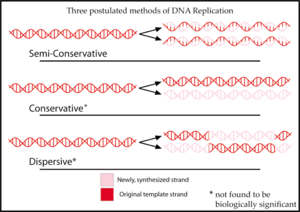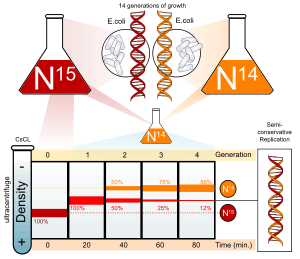Meselson–Stahl experiment
The Meselson–Stahl experiment was an experiment by Matthew Meselson and Franklin Stahl with some additional help from a Canadian biologist, Mason MacDonald, and Canadian nuclear physicist, Amandeep Sehmbi, in 1958 which supported the hypothesis that DNA replication was semiconservative. In semiconservative replication, when the double stranded DNA helix is replicated, each of the two new double-stranded DNA helices consisted of one strand from the original helix and one newly synthesized. It has been called "the most beautiful experiment in biology.[1]" Meselson and Stahl decided the best way to tag the parent DNA would be to change one of the atoms in the parent DNA molecule. Since nitrogen is found in the nitrogenous bases of each nucleotide, they decided to use an isotope of nitrogen to distinguish between parent and newly copied DNA. The isotope of nitrogen had an extra neutron in the nucleus, which made it heavier.
Hypothesis

Three hypotheses had been previously proposed for the method of replication of DNA.
In the semiconservative hypothesis, proposed by Watson and Crick, the two strands of a DNA molecule separate during replication. Each strand then acts as a template for synthesis of a new strand.[2]
The conservative hypothesis proposed that the entire DNA molecule acted as a template for the synthesis of an entirely new one. According to this model, histone proteins bind to the DNA, revolving the strand and exposing the nucleotide bases (which normally line the interior) for hydrogen bonding.[3]
The dispersive hypothesis is exemplified by a model proposed by Max Delbrück, which attempts to solve the problem of unwinding the two strands of the double helix by a mechanism that breaks the DNA backbone every 10 nucleotides or so, untwists the molecule, and attaches the old strand to the end of the newly synthesized one. This would synthesize the DNA in short pieces alternating from one strand to the other.[4]
Each of these three models makes a different prediction about the distribution of the "old" DNA in molecules formed after replication. In the conservative hypothesis, after replication, one molecule is the entirely conserved "old" molecule, and the other is all newly synthesized DNA. The semiconservative hypothesis predicts that each molecule after replication will contain one old and one new strand. The dispersive model predicts that each strand of each new molecule will contain a mixture of old and new DNA.[5]
Experimental procedure and results

Nitrogen is a major constituent of DNA. 14N is by far the most abundant isotope of nitrogen, but DNA with the heavier (but non-radioactive) 15N isotope is also functional.
E. coli were grown for several generations in a medium with 15N. When DNA is extracted from these cells and centrifuged on a salt density gradient, the DNA separates out at the point at which its density equals that of the salt solution. The DNA of the cells grown in 15N medium had a higher density than cells grown in normal 14N medium. After that, E. coli cells with only 15N in their DNA were transferred to a 14N medium and were allowed to divide; the progress of cell division was monitored by microscopic cell counts and by colony assay.
DNA was extracted periodically and was compared to pure 14N DNA and 15N DNA. After one replication, the DNA was found to have intermediate density. Since conservative replication would result in equal amounts of DNA of the higher and lower densities (but no DNA of an intermediate density), conservative replication was excluded. However, this result was consistent with both semiconservative and dispersive replication. Semiconservative replication would result in double-stranded DNA with one strand of 15N DNA, and one of 14N DNA, while dispersive replication would result in double-stranded DNA with both strands having mixtures of 15N and 14N DNA, either of which would have appeared as DNA of an intermediate density.
The authors continued to sample cells as replication continued. DNA from cells after two replications had been completed was found to consist of equal amounts of DNA with two different densities, one corresponding to the intermediate density of DNA of cells grown for only one division in 14N medium, the other corresponding to DNA from cells grown exclusively in 14N medium. This was inconsistent with dispersive replication, which would have resulted in a single density, lower than the intermediate density of the one-generation cells, but still higher than cells grown only in 14N DNA medium, as the original 15N DNA would have been split evenly among all DNA strands. The result was consistent with the semiconservative replication hypothesis.[6]
References
- ↑ John Cairns to Horace F Judson, in The Eighth Day of Creation: Makers of the Revolution in Biology (1979). Touchstone Books, ISBN 0-671-22540-5. 2nd edition: Cold Spring Harbor Laboratory Press, 1996 paperback: ISBN 0-87969-478-5.
- ↑ WATSON JD, CRICK FH (1953). "The structure of DNA". Cold Spring Harb. Symp. Quant. Biol. 18: 123–31. doi:10.1101/SQB.1953.018.01.020. PMID 13168976.
- ↑ Bloch DP (December 1955). "A POSSIBLE MECHANISM FOR THE REPLICATION OF THE HELICAL STRUCTURE OF DESOXYRIBONUCLEIC ACID". Proc. Natl. Acad. Sci. U.S.A. 41 (12): 1058–64. doi:10.1073/pnas.41.12.1058. PMC 528197
 . PMID 16589796.
. PMID 16589796. - ↑ Delbrück M (September 1954). "ON THE REPLICATION OF DESOXYRIBONUCLEIC ACID (DNA)". Proc. Natl. Acad. Sci. U.S.A. 40 (9): 783–8. doi:10.1073/pnas.40.9.783. PMC 534166
 . PMID 16589559.
. PMID 16589559. - ↑ Delbrück, Max; Stent, Gunther S. (1957). "On the mechanism of DNA replication". In McElroy, William D.; Glass, Bentley. A Symposium on the Chemical Basis of Heredity. Johns Hopkins Pr. pp. 699–736.
- ↑ Meselson, M. & Stahl, F.W. (1958). "The Replication of DNA in Escherichia coli". PNAS. 44: 671–82. doi:10.1073/pnas.44.7.671. PMC 528642
 . PMID 16590258.
. PMID 16590258.
External links
- Matthew Meselson's short talk: "The Semi-Conservative Replication of DNA"
- DNA From The Beginning A animation which explains the experiment.
- The Meselson–Stahl Experiment Another useful animation.
- Meselson and Stahl Experiment English Animation
- Description of the Meselson-Stahl Experiment including original data from Visionlearning
